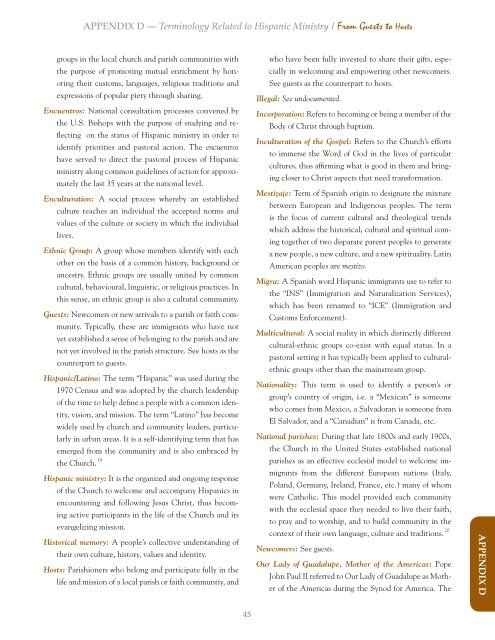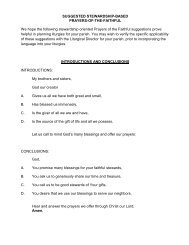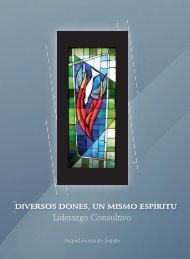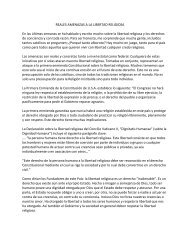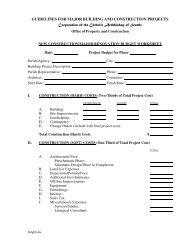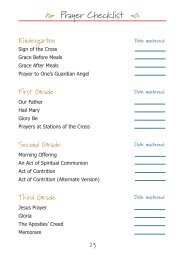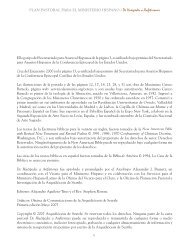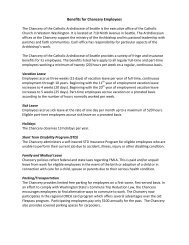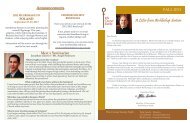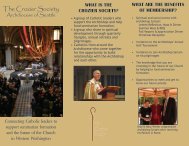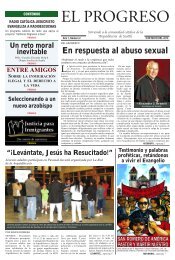Pastoral Plan for HisPanic Ministry / From Guests to Hosts Hispanic ...
Pastoral Plan for HisPanic Ministry / From Guests to Hosts Hispanic ...
Pastoral Plan for HisPanic Ministry / From Guests to Hosts Hispanic ...
You also want an ePaper? Increase the reach of your titles
YUMPU automatically turns print PDFs into web optimized ePapers that Google loves.
Appendix D — Terminology Related <strong>to</strong> <strong>Hispanic</strong> <strong>Ministry</strong> / <strong>From</strong> <strong>Guests</strong> <strong>to</strong> <strong>Hosts</strong>groups in the local church and parish communities withthe purpose of promoting mutual enrichment by honoringtheir cus<strong>to</strong>ms, languages, religious traditions andexpressions of popular piety through sharing.Encuentros: National consultation processes convened bythe U.S. Bishops with the purpose of studying and reflectingon the status of <strong>Hispanic</strong> ministry in order <strong>to</strong>identify priorities and pas<strong>to</strong>ral action. The encuentroshave served <strong>to</strong> direct the pas<strong>to</strong>ral process of <strong>Hispanic</strong>ministry along common guidelines of action <strong>for</strong> approximatelythe last 35 years at the national level.Enculturation: A social process whereby an establishedculture teaches an individual the accepted norms andvalues of the culture or society in which the individuallives.Ethnic Group: A group whose members identify with eachother on the basis of a common his<strong>to</strong>ry, background orancestry. Ethnic groups are usually united by commoncultural, behavioural, linguistic, or religious practices. Inthis sense, an ethnic group is also a cultural community.<strong>Guests</strong>: Newcomers or new arrivals <strong>to</strong> a parish or faith community.Typically, these are immigrants who have notyet established a sense of belonging <strong>to</strong> the parish and arenot yet involved in the parish structure. See hosts as thecounterpart <strong>to</strong> guests.<strong>Hispanic</strong>/Latino: The term “<strong>Hispanic</strong>” was used during the1970 Census and was adopted by the church leadershipof the time <strong>to</strong> help define a people with a common identity,vision, and mission. The term “Latino” has becomewidely used by church and community leaders, particularlyin urban areas. It is a self-identifying term that hasemerged from the community and is also embraced by19the Church.<strong>Hispanic</strong> ministry: It is the organized and ongoing responseof the Church <strong>to</strong> welcome and accompany <strong>Hispanic</strong>s inencountering and following Jesus Christ, thus becomingactive participants in the life of the Church and itsevangelizing mission.His<strong>to</strong>rical memory: A people’s collective understanding oftheir own culture, his<strong>to</strong>ry, values and identity.<strong>Hosts</strong>: Parishioners who belong and participate fully in thelife and mission of a local parish or faith communtiy, andwho have been fully invested <strong>to</strong> share their gifts, especiallyin welcoming and empowering other newcomers.See guests as the counterpart <strong>to</strong> hosts.Illegal: See undocumented.Incorporation: Refers <strong>to</strong> becoming or being a member of theBody of Christ through baptism.Inculturation of the Gospel: Refers <strong>to</strong> the Church’s ef<strong>for</strong>ts<strong>to</strong> immerse the Word of God in the lives of particularcultures, thus affirming what is good in them and bringingcloser <strong>to</strong> Christ aspects that need trans<strong>for</strong>mation.Mestizaje: Term of Spanish origin <strong>to</strong> designate the mixturebetween European and Indigenous peoples. The termis the focus of current cultural and theological trendswhich address the his<strong>to</strong>rical, cultural and spiritual coming<strong>to</strong>gether of two disparate parent peoples <strong>to</strong> generatea new people, a new culture, and a new spirituality. LatinAmerican peoples are mestizo.Migra: A Spanish word <strong>Hispanic</strong> immigrants use <strong>to</strong> refer <strong>to</strong>the “INS” (Immigration and Naturalization Services),which has been renamed <strong>to</strong> “ICE” (Immigration andCus<strong>to</strong>ms En<strong>for</strong>cement).Multicultural: A social reality in which distinctly differentcultural-ethnic groups co-exist with equal status. In apas<strong>to</strong>ral setting it has typically been applied <strong>to</strong> culturalethnicgroups other than the mainstream group.Nationality: This term is used <strong>to</strong> identify a person’s orgroup’s country of origin, i.e. a “Mexican” is someonewho comes from Mexico, a Salvadoran is someone fromEl Salvador, and a “Canadian” is from Canada, etc.National parishes: During that late 1800s and early 1900s,the Church in the United States established nationalparishes as an effective ecclesial model <strong>to</strong> welcome immigrantsfrom the different European nations (Italy,Poland, Germany, Ireland, France, etc.) many of whomwere Catholic. This model provided each communitywith the ecclesial space they needed <strong>to</strong> live their faith,<strong>to</strong> pray and <strong>to</strong> worship, and <strong>to</strong> build community in the20context of their own language, culture and traditions.Newcomers: See guests.Our Lady of Guadalupe, Mother of the Americas: PopeJohn Paul II referred <strong>to</strong> Our Lady of Guadalupe as Motherof the Americas during the Synod <strong>for</strong> America. TheAppendix D45


